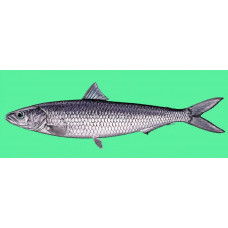Latin name
Sardinella aurita
Other name
Sardinella aurita
Identification
The round sardinella is similar to the European sardine in body structure, but differs from it in having a more elongated and thicker body. It has 47-49 vertebrae. The body is elongated, usually subcylindrical, but sometimes slightly compressed. The belly is rather rounded, but with a distinct keel. The lower gills are slender and numerous, more than 80. The anterior gills on the lower extremities of the second and third gill arches are more or less flat. Gill stamens thin and delicate, slightly exceeding the length of the gill lobes. The keel scales are pointed.
Features of fish fins
Dorsal spines (total): 0; Dorsal soft rays (total): 17 - 20; Anal spines: 0; Anal soft rays: 16 - 18.
The caudal fin of these fish is strongly forked. The pelvic fin has 8 separate rays, which distinguishes this species from others in the genus.
Fish colouring
The back of the round sardinella is bluish-green, the sides are silvery. The yellow stripe on the sides may appear brown.
Distribution
The species is found in the Mediterranean (rare in the Black Sea), in the eastern Atlantic from Gibraltar to Saldanha Bay, South Africa. In the western Atlantic from Cape Cod in the USA to Argentina, also in the waters of the Bahamas, Antilles, Caribbean and Gulf of Mexico.
Habitat
Coastal pelagic species preferring clear saline waters. Occurs inshore and near the surface to the shelf edge and at depths of up to 350 metres, and possibly deeper. Lives at depths of 10 to 80 metres, sometimes near the surface or at depths of up to 350 metres. Juveniles often stay close to their birth sites and only when they reach maturity do they begin to swim long distances in deep, cold water. It prefers water temperatures from 14.5 to 30° C and salinities no lower than 34 ‰.
Size
The maximum body length of males of this species is 41.0 cm, with a total length of 25.0 cm. The maximum reported weight is 420.00 g. The maximum reported age is 7 years. The head is relatively small and broad, with a length of 19.0% of the body length and an interorbital space of 20.0% of the head length. One year old fish reach a length of 14-16 cm, three year old fish 22-28 cm and by the end of the fifth year of life 26-34 cm.
Behavior
These fish live in large schools. They make vertical feeding migrations, rising to the surface at night and sinking into the water column or benthic layer to depths of up to 200 metres during the day. After spawning they form large benthic aggregations.
Food and feeding habits
Round sardinella feed mainly on zooplankton, but also on phytoplankton, especially juveniles.
Reproduction
Breeding and spawning occur throughout the year. These fish reach sexual maturity at the age of 1-2 years, when they reach a length of 12-13 or 15-16 cm. Spawning takes place in the coastal zone, at depths of up to 50 metres. Juveniles develop close to the shore, in the warm waters of estuaries and lagoons. As the salinity of the water decreases during the rainy season, the fish move away from the shore.
Fishing
The species is an important fishing target. The main fishing grounds are the West African coast, the Mediterranean and the coasts of Venezuela and Brazil.
Relationship with a person
Harmless. Compared to other sardinellas, it is a less fatty fish, with a body fat content of between 0.5% and 10%.
Interesting facts
Not all fish react the same way to artificial light. Some are attracted to it, while others are repelled by it. In the Mediterranean Sea, fishermen have long used torchlight to lure round sardinella.
| Classification | |
| Phylum | Chordata |
| Class | Actinopterygii |
| Squad | Clupeiformes |
| Family | Dorosomatidae |
| Genus | Sardinella |
| Species | S. aurita |
| Features | |
| Conservation status | Least Concern |
| Habitat | Pelagic |
| Life span, years | No information |
| Maximum body weight, kg | 0,42 |
| Maximum length, cm | 41 |
| Sailing speed, m/s | No information |
| Threat to people | Edible |
| Way of eating | Planktonophage |
Round sardinella
Tags: round sardinella


